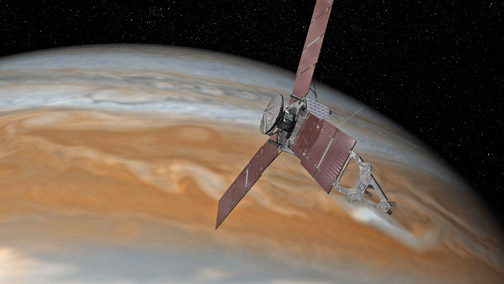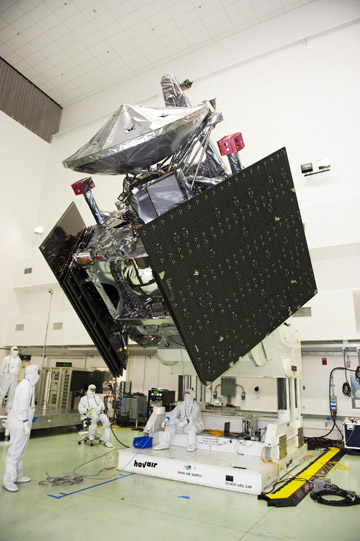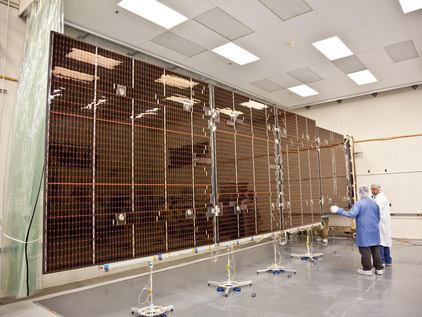NASA’s Juno mission to Jupiter had an important date on Monday night, July 4th . A date with Jupiter. Juno has slipped into orbit around the planet after a five year trip. As it approached its destination, the planets tremendous gravitational pull accelerated the 3,500 pound spacecraft to speeds of more than 150,000 mph, making Juno the fastest human-made object ever built. Mission managers fired Juno's main engine for 35 minutes starting at 8:18 pm Pacific (11:18 ET). The accurate engine blast slowed the spacecraft and allowed it to be pulled into a polar orbit around Jupiter.

Fig. 1: Juno spacecraft became 'fastest object ever made' during flight to Jupiter.
Engineers at Lockheed Martin Space Systems designed a special radiation vault made of titanium for the crafts centralized electronics hub. While other materials exist that make good radiation blockers, they chose titanium because lead is too soft to withstand the vibrations of launch and some other materials were too difficult to work with.
Each titanium wall measures nearly 9 square feet in area, and about 1 centimeter (a third of an inch) thick. This box encloses Juno's command and data handling unit, power and data distribution unit, and about 20 other electronic assemblies. The whole vault weighs about 172 kilograms (~400 pounds) and will reduce the exposure to radiation by 800 times. The vault will not completely prevent every Jovian electron, ion, or proton from hitting the system, but it will dramatically slow down the aging effect radiation has on electronics for the duration of the mission.
Juno uses a RAD750 radiation hardened processor from BAE systems. It is a licensed, rad-hard version of the IBM PowerPC 750 with performance of better than 400 MIPS operating at 200 MHz and uses 0.15 μm radiation-hardened bulk CMOS. The IC operates over -55° to 125°C and is in a 360-pin ceramic package with CGA. The first RAD750 flight units were launched in 2005 on Deep Impact, XSS-11, and Mars Reconnaissance Orbiter missions. Since then 28 additional RAD750 microprocessors have been launched.

Fig. 2: The Juno spacecraft.
Jupiter's magnetosphere, wider and flatter than the Earth's, is stronger by an order of magnitude. Its magnetic moment is roughly 18,000 times larger. The existence of Jupiter's magnetic field was first inferred from observations of radio emissions at the end of the 1950s and was directly observed by the Pioneer 10 spacecraft in 1973.
The Jovian magnetosphere traps and accelerates particles, producing intense belts of radiation similar to Earth's Van Allen belts, but thousands of times stronger. The interaction of energetic particles with the surfaces of Jupiter's largest moons markedly affects their chemical and physical properties. Those same particles also affect, and are affected by, the motions of the particles within Jupiter's planetary ring system. The radiation belts present a significant hazard for spacecraft.
“We are not looking for trouble, we are looking for data,” said Scott Bolton, principal investigator of Juno from the Southwest Research Institute in San Antonio. “Problem is, at Jupiter, looking for the kind of data Juno is looking for, you have to go in the kind of neighborhoods where you could find trouble pretty quick.”
The source of trouble can be found inside Jupiter. Well below the Jovian cloud tops is a layer of hydrogen under such incredible pressure it acts as an electrical conductor. Scientists believe that the combination of this metallic hydrogen along with Jupiter's fast rotation – a day on Jupiter is only 10 hours long – generates a powerful magnetic field that surrounds the planet with electrons, protons and ions traveling at nearly the speed of light. The endgame for any spacecraft that enters this doughnut-shaped field of high-energy particles is an encounter with the harshest radiation environment in the solar system.
The mission plan involves 32 orbits, skimming to within 3,100 miles (5,000 kilometers) above the planet's cloud tops, over 12+ months. “The orbits that we have go far away from Jupiter over most of the orbit,” says Kevin Rudolph, an engineer at Lockheed Martin, “and when they come in close, they dive quickly through the intense part, then fly below the radiation and go back out quickly.”
The spacecraft’s external parts have added protection. The navigation camera that looks at the stars is wrapped in an inch-thick canister, with just one end open. The solar panel arrays have a 12-millimeter-thick sheet of glass over the top. The glass provides a small amount of protection against radiation and damaging dust particles.

Fig. 3: One of Juno's solar panels before illumination test.
In orbit around Jupiter, at a distance of 5 AU from the Sun, Juno will receive 4% as much sunlight as it would near Earth. Two of Juno’s huge solar panels have four hinged segments each, and the third panel has three segments. Each panel is 2.7 meters (8.9 ft) by 8.9 meters (29 ft) long. They generate 486 W, declining to near 420 W as radiation degrades them. Two 55 amp/hour lithium-ion batteries augment the solar arrays
Juno's scientific payload includes:
- A gravity/radio science system (Gravity Science)
- A six-wavelength microwave radiometer for atmospheric sounding and composition (MWR)
- A vector magnetometer (MAG)
- Plasma and energetic particle detectors (JADE and JEDI)
- A radio/plasma wave experiment (Waves)
- An ultraviolet imager/spectrometer (UVS)
- An infrared imager/spectrometer (JIRAM)
The spacecraft also carries a color camera, called JunoCam, to provide the first detailed look at Jupiter's poles.
Advertisement
Learn more about Electronic Products Magazine





